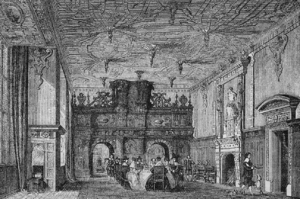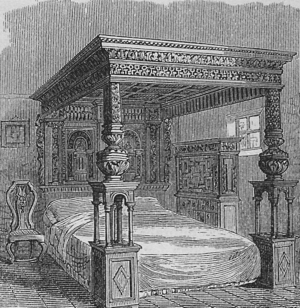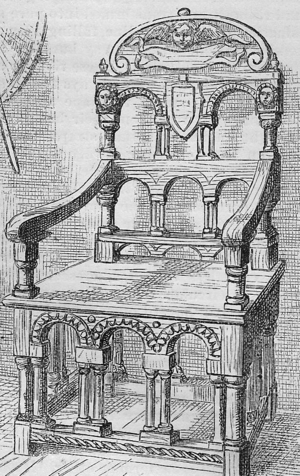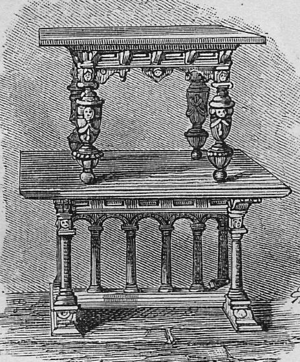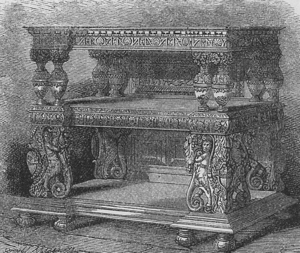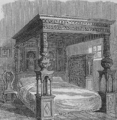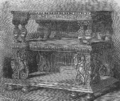Elizabethan and Jacobean furniture facts for kids
Elizabethan furniture is a special style of furniture and decoration that became popular in England during the time of Queen Elizabeth I. It was part of the big art movement called the Renaissance, which started in Italy. This English style was unique, just like the furniture styles in France and Italy during that period.
Contents
How the Style Developed Slowly
Before the Elizabethan era, English buildings and furniture were mostly in the Gothic style. This style had tall, pointed arches. Over time, it slowly changed towards the lower, flatter look of the Tudor style. This change was partly influenced by new ideas from Italy.
However, England was a bit isolated, so new styles took a long time to arrive and be fully adopted. Even during Queen Elizabeth I's reign, the change wasn't complete. For example, arches from the time of King Henry VIII (before Elizabeth) were almost flat, not tall and pointed.
New ideas from the Italian Renaissance spread slowly to England. Even though many artists from other countries, like Pietro Torrigiano and Hans Holbein the Younger, worked for the Tudor court, they were still ahead of the general English style.
The famous writer William Shakespeare even mentioned how England was slow to pick up new trends, saying England "limps after" the "fashions of proud Italy." This shows that English styles were often behind those on the European continent.
Even though some fancy Renaissance furniture was bought from other countries for the royal family, most English furniture was a mix of old and new. This was happening when France had the elegant Henry II style and Italy had the amazing cinquecento style.
The term "Elizabethan" for furniture doesn't just mean the exact years Queen Elizabeth I ruled. It describes a style that started a few years before she was born and continued even after she died. It's hard to say exactly when one style ends and another begins because they often blend together. For example, some chairs called Elizabethan were used much earlier, and some buildings from Elizabeth's later years had features that are more like the Jacobean style.
Classical Influences in Design
Elizabethan furniture often tried to use ideas from ancient Greek and Roman art. Sometimes, like in a fireplace mantel, this worked really well, creating a grand and beautiful piece with columns and decorative borders.
However, many attempts were not perfect. You might see columns that look too thick or details that don't quite make sense. Often, these columns would have straps or buckles wrapped around them, along with clumsy scrolls and flowers. You might also see faces or busts of ancient figures, or strange human figures.
Large, thick columns were a main part of beds, tables, and cabinets. These columns often had big, round clusters of leaves (like the acanthus plant) at their base. Sometimes, another big leafy ball would break the column in the middle. The lower part of the columns might be covered with swirly arabesque patterns, while the top part was fluted (grooved) or had a fine scale-like carving.
Some tables didn't have columns. Instead, they had supports shaped like half-human, half-animal figures, called caryatids. These figures were often female, dressed in straps, and ended in rough scrolls.
The tables were very heavy and strong. Some could be extended, but many were fixed and almost impossible to move because of their weight. Cabinets usually had a closed cupboard at the bottom with decorated panels. The top part stuck out and was held up by large columns. All surfaces were richly carved.
One famous example is the Great Bed of Ware. It followed the Elizabethan style but was incredibly huge. It was about 12 feet (3.7 meters) square, which was big even for that time, though similar large beds existed in other countries.
Even with all the classical shapes, the "strap and buckle" design was the most common and important feature.
The "Strap and Buckle" Style
Strapwork was a very popular design in Elizabethan furniture. It looked like flat straps or ribbons that were woven together, often with buckles. This style was also used in jewelry.
In both French and Italian art, strapwork was mixed with more detailed classical designs and natural shapes. But in Elizabethan England, this strapwork became very important and was used everywhere. Even though the basic idea was simple, the way the lines curved and intertwined was endless. These straps and ribbons would interlace, creating complex patterns that looked like the fancy buckles and harnesses used in chivalry.
These straps and ribbons were always flat on the surface, even if they curved. They stood out from the background as if real straps were laid flat. They focused on the effect of lines chasing each other, rather than using light and shadow.
Later, when cartouches (decorative frames, often shield-shaped) became popular, they added some light and shadow. The supports of these shields were often pierced with many openings (like crescents, diamonds, circles), creating an openwork pattern that repeated the strap and ribbon designs. This pierced shieldwork became even more important in the Jacobean period, but strapwork was found on almost everything Elizabethan.
Large screens between rooms and even walls were covered with this carved strapwork, like in Crewe Hall. Ceilings also had carved designs, with intersecting curves and angles that looked very grand.
Heraldry, which involves family shields and crests, was also a big part of Elizabethan decoration. Family coats of arms, often with the family motto and the initials of a husband and wife, were carved over doorways, fireplaces, and on walls. Stairways were decorated with carved monsters holding family arms.
Sometimes, rooms had a mix of styles. For example, wall panels might be in the older square or parchment shapes, or in the round-arched style unique to the Elizabethan period. You can see small versions of these round-arched panels on the back of a chair made from the wood of Sir Francis Drake's ship.
Gothic Style Still Present
Even with all the new Renaissance ideas, the old Gothic style was never completely forgotten in Elizabethan furniture. Its vertical lines often broke through the horizontal lines of the new classical designs. Old Gothic monsters seemed to look unkindly at the new, strange creatures. Gothic ornaments insisted on their place next to the Greek ones.
In buildings, Gothic gables (the triangular parts of walls under a sloping roof) still rose, even if their outlines were changed by new scroll designs. In furniture, the curved tops of cabinets still showed Gothic influences, even if their fronts looked like classical temples. The English people held onto the old ways and slowly let go of a style that had been part of their lives for centuries. If they had to have new designs, they still wanted some of the old ones too.
So, when Renaissance ideas came to England (after the Wars of the Roses ended and people could focus on art again), they were changed by the Gothic style. This created a unique mix.
Influence from the Low Countries
Many Renaissance ideas came to England through the Low Countries (modern-day Belgium and the Netherlands). A lot of furniture was imported from Flanders and Holland during this time. In fact, so much was imported that a law was made a hundred years earlier to try and stop it! But carved woodwork from the Low Countries was still a very important trade item. Many English country homes of this period were filled with Dutch and Flemish furniture.
Several things led to this influence:
- Many people from the Low Countries came to live in England to escape Spanish rule.
- English forces were involved in the Dutch Revolt (a war for independence).
- English people felt sympathy for the struggles in the Netherlands.
Whether it was these reasons or just trade, the Elizabethan furniture style adopted the heavy, often overloaded Dutch cabinets and tables with thick, strong legs. These pieces were covered with Flemish decorations. Because these items were so valuable, many fakes were made in Holland much later.
The Flemings (people from Flanders) loved grand and magnificent things, but they never fully mastered the Italian Renaissance style. Their craftsmanship also didn't always match their ideas perfectly. German and Spanish workmanship were closer to the true spirit of the Renaissance. However, Flemish carving is often seen as the most dramatic in Northern Europe.
Over time, Flemish work became less refined. It often had pieces of turned wood cut in half and glued on, or panels that overlapped at strange angles. This made the furniture look clumsy and sometimes ugly. In the later Elizabethan period, Italian artists might have worked on furniture in England, but they probably had to adapt to the existing English tastes. Early Elizabethan carving often looked a bit rough, but this gave it a strong, broad effect. The old carvers didn't hide their methods and even left tool marks visible.
The Scallop Shell Design
In the later part of the Elizabethan style, which is often called Jacobean, the round shapes on columns became longer and more acorn-shaped. More inlaid work (where pieces of different materials are set into a surface) was used. Carving tried its best to copy the ideas of the Italian cinquecento. Surfaces were covered with carvings of griffins, vases, rosettes, dolphins, scrolls, leaves, Cupids, and mermaids with double tails. The cartouche and strapwork were still used often.
Scallop shells became very popular. They had recently been brought back from foreign seas and designers quickly used them in their work. Flemish makers created chairs that looked like the sitter was enclosed in the two halves of a scallop shell. The designer Francis Cleyn is linked to the scallop shell back for chairs. Some settees (long seats) from this time had backs made of several huge scallop shells. This shell design also appeared in fan-like frills on other furniture. While these shell forms might suit a seaside home, they must have looked very unusual among the heavy furniture in Jacobean mansions.
Overall, early Elizabethan furniture had a sense of dignity and grandness that matched the era and the queen. It also went well with the huge dresses (farthingales) and ruffs worn by ladies, and the puffed clothes of gentlemen. The famous people who used this furniture, like Shakespeare, Walter Raleigh, Ben Jonson, and Francis Bacon, make it even more interesting.
While it suited Queen Elizabeth I, the styles that developed under her successor, King James I, with their foreign ideas and lots of gilding (gold decoration), also matched his arrogant and scholarly personality. All this furniture is very appealing today, and many people would love to own a piece, as long as it's not too big for modern homes! A typical sideboard or dresser from this time would have a mix of designs: fawns, satyrs, fruits, flowers, Cupids, birds, scrolls, shields, straps, cornucopias, mermaids, monsters, and leaves. These belong to the beginning of the later period. Moving such heavy furniture for a dance, as mentioned in Shakespeare's Romeo and Juliet, was no easy task!
Porcelain and Mirrors
By the end of the Jacobean era, the furniture style changed little for several reigns. Carving became rougher at first during the time of the first Stuart kings, but later became very fine. Inlaid work was also used more and became excellent. Everything became more luxurious.
Fine pottery, for example, became more common. While glass was made in London during Elizabeth's time, "porselyn" (porcelain) was rare. Even everyday earthenware wasn't very common. Rich people used gold and silver plates, while poorer people used pewter mugs and wooden plates. It was considered unusual when "five dishes of earth painted, such as are brought from Venice," were given to the queen. And it was a special gift when Lord Burleigh gave her a "porringer of white porselyn garnished with gold." The first use of the famous Dutch tiles is thought to be during the reign of King Charles I.
Mirrors were very rare in Elizabeth's time but became more common during the reigns of the Charleses. The Duke of Buckingham even brought Venetian glassmakers to Lambeth (London) during the time of Charles II. One Elizabethan mirror was about 3.5 by 4.5 feet (1.1 by 1.4 meters). Its frame was carved oak and partly gilded, and the glass was flat. Later mirrors had beveled (angled) edges, which gave them a special sparkle. Sometimes, whole rooms and even ceilings were lined with mirrors! The mirrors made by the duke's glassmakers were excellent, with a one-inch wide bevel all around the edge. This bevel created a beautiful, sparkling light.
Wall hangings had been used for a long time, including leather, damask, velvet, and tapestry. Flemish tapestries were very popular. Queen Elizabeth even had a set made to celebrate the defeat of the Spanish Armada. These tapestries became so fine that they were often preferred over other decorations. During the Stuart period, they were even stretched over the beautiful carved wooden panels on walls.
Later, French tapestries, like those from the Gobelins manufactory, became very famous for their design and quality. They showed scenes like palaces, hunts, figures, and landscapes. However, tapestry making had also been supported by royalty in England. King Charles I bought the Raphael cartoons (large drawings) for the Mortlake Tapestry Works. Draperies (heavy curtains) also became very common and began to replace the heavy wooden tops on beds.
Images for kids
See also


